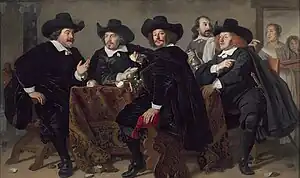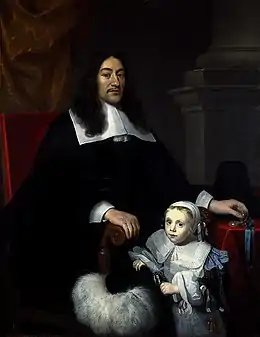Johannes Klencke
Johannes Klencke, van Klenck or Klenckius (bapt. 5 March 1620, in Amsterdam – early 1672, in Batavia, Dutch East Indies) was a Dutch teacher in philosophy at the Athenaeum Illustre in Amsterdam.


Life
Johannes Klenck was the eldest son[1] of a trader in Russian caviar and studied theology in Leiden. On 24 May 1644 he accepted a post on issues concerning morality. There he introduced debating with the students. In 1648 he was appointed professor of philosophy at the illustrious school of Amsterdam.[2] He taught physics, metaphysics, logic, ethics and politics.
In May 1660, acting on behalf of a consortium of Dutch sugar merchants with plantations in the Caribbean, he offered the Klencke Atlas to the King, hoping to gain favourable trade agreements with Britain.[3][4]
In July 1660, Louis of Nassau arrived in London; his countrymen Simon van Hoorn, curator of the Athenaeum, Michiel van Gogh and the Roman Catholic Joachim Ripperda arrived in November to present to Charles II the Dutch Gift,[5][6] consisting of furniture, a yacht, 24 paintings, and twelve statues to celebrate the Restoration in 1661?[7] The three envoys were assisted by 24 servants and a few clerks [8] when they left Den Briel on 29 October 1660.[9] Klencke, an expert on Grotius, may have accompanied them, to discuss 'unrestricted trade', and the Act of Navigation.[10]
He was made a knight on 19 September 1660.[11][4] In 1669 he left Amsterdam for Paris and London. According to Isaac Vossius, Klencke was silly and insane.[12] In 1672 he died suddenly at Batavia.[13]
Relatives
Ernst van Klenck, a merchant trading with Russia, married in 1660 a daughter of Pieter de Carpentier. In 1661 his brother Herman van Klenck was appointed as a Governor of Formosa (now called Taiwan), but never set a foot on the island when he noticed Fort Zeelandia was occupied by the Chinese soldier Koxinga. Coenraad van Klenck, a trader on Russia and member of the Amsterdam vroedschap, was an envoy to Russia in 1675. Their brother-in-law William Davidson of Curriehill invited Mary Stuart into his house in July 1660 and seems to have been a spy for Charles II. In 1660 he was rewarded with an appointment as conservator of the Staple in Veere.[14]
Notes
- Tullekens, Josias, The Montias Database of 17th Century Dutch Art Inventories, The Frick Collection. Last accessed 20 June 2011
- Humanism in an age of science: the Amsterdam Athenaeum in the golden age, by Dirk van Miert pg. 68
- Tom Harper. "The Klencke Atlas". British Museum. Retrieved 13 May 2017.
- Peter Barber. The Map Book, Bloomsbury Publishing USA, 2005. pg. 164
- European Treaties Bearing on the History of the United States and Its ..., Frances Gardiner Davenport, Charles O. Paullin, pg. 73
- Thiel, P.J.J. (1965) Het Nederlandse geschenk aan koning Karel II van Engeland 1660, p. 6.
- Klencke Atlas 1660 - The Beauty of Maps - Episode 3 - BBC Four
- Lammertse, F. & J. van der Veen (2006) Uylenburgh & Zoon. Kunst en commercie van Rembrandt tot Lairesse, p. 65.
- Logan, Anne-Marie S. , "The 'Cabinet' of the Brothers Gerard and Jan Reynst" (Amsterdam, 1979), p. 79.
- Israel, J.I., The Dutch Republic; Its rise, greatness, and fall 1477-1806 (Oxford 1998), p. 749-750.
- Tom Harper. "The Klencke Atlas". British Museum. Retrieved 13 May 2017.
- Dirk van Miert (2005). Illuster Onderwijs. Het Amsterdamse Athenaeum in de Gouden Eeuw, 1632-1704 (in Dutch). Bert Bakker. pp. 75, 114, 145.
- Nieuw Nederlandsch Biografisch Woordenboek (NNBW)
- National Galleries Scotland